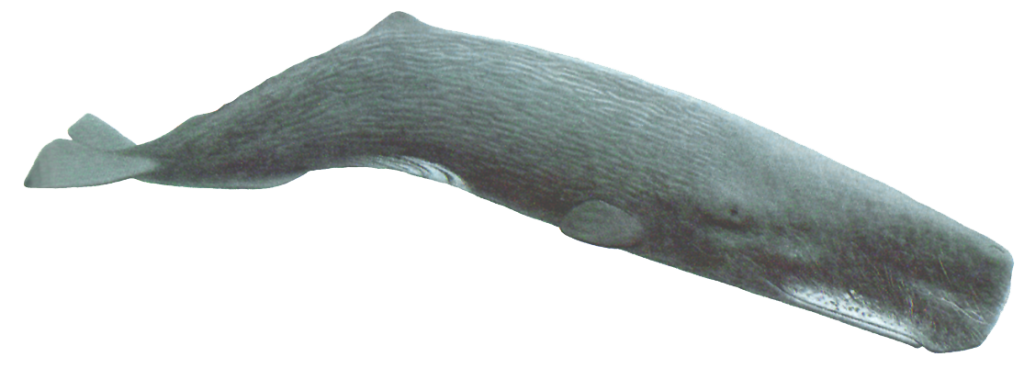 Family: Physeteridae
Family: Physeteridae
Genus: Physeter
Species: P. macrocephalus Linnaeus, 1758
Taxonomic Note: Physeter catadon is sometimes used, although Physeter macrocephalus takes precedence.
When most people think of a whale, the sperm whale is the animal that comes to mind, mostly because of the great sperm whale tale, Moby Dick, in Herman Melville’s classic novel of that name. They are the most numerous of the great whales and were the basis of the success of early American whaling operations. Sperm whales have a huge, squarish forehead, small, inconspicuous eyes, and a very thin lower jaw which fits into the large head. The forehead contains the spermaceti organ, a name given to it by early whalers who believed the organ contained sperm. Actually, the organ contains a high quality oil that when removed from the body and cooled takes on a waxy quality. The late Dr. Kenneth S. Norris, of the University of California at Santa Cruz, proposed that the sperm whale may use the spermaceti organ to produce noises so loud that they stun the whale’s prey.
The disproportionately small eyes of the sperm whale probably do not play a large role in the daily activities of the animal. These whales often feed at such depths (over 3,000 ft or 900 m) that eyes must prove of little value in their quest for food.
The lower jaw of the sperm whale reaches 15 ft (4.5 m) in length and contains up to 50 of the most massive teeth on earth. The upper jaw contains no visible teeth, and it is a wonder how these animals prove so formidable in their pursuit of giant squid, the mainstay of their diet.
While they are found in all oceans — almost exclusively in deep water — their distribution is regulated by habit and migration. During the latter the populations separate by age and sex. In summer, most of the adolescent and mature males form “bachelor pods” and migrate to the cold nutrient-rich waters of the high latitudes, while the females and young animals form “nursing pods” and remain in temperate waters.
Physical Description: The skin is rippled over much of the body, especially on the back and sides. The body shape is unique among cetaceans, with a squared head region constituting about one-third of the total body length. The sperm whale has a single blowhole, located on the left side of the slope of the forehead. About one in every 200 sperm whales has a deformed lower jaw which does not seem to interfere with feeding.
Color: Light brown to blue-gray, often with distinctly lighter shading around the belly and jaw. The lips are marbles outside the white mouth.
Fins and Flukes: In place of a dorsal fin, a series of bumps, often including a single large triangular bump, extends along the ridge of the spine from mid-back almost to the tail. The small, stubby flippers are located well to the rear of the eyes — themselves located just above the convergence of the upper and lower jaws. The small, broad, thin flukes have rounded tips and a definite median notch. The flukes are often disfigured or serrated along their trailing edges.
Length and Weight: Males reach 60 ft (18.5 m) and weigh 35 to 50 tons (32,000 to 45,000 kg); females reach 40 ft (12 m) and 18 tons (16,000 kg).
Teeth: The 18 to 25 large, conical teeth in each side of the lower jaw fit into sockets in the upper jaw. The 10 to 16 teeth in the upper jaw rarely erupt through the gums.
Feeding: Squid is the primary food.
Breathing and Diving: This whale can dive to depths of at least 3,300 ft (1,000 m) and can remain underwater for over an hour. Prior to a lengthy dive a sperm whale may remain at the surface for about 10 minutes, blowing every 10 to 30 seconds, then raise its flukes high out of the water and submerge. The blow is forward and to the left.
Mating and Breeding: A 12 to 14 ft (3.7 to 4.3 m) calf weighing 1 ton (900 kg) is born after a gestation period of 16 months. Lactation lasts up to 24 months. Males attain sexual maturity at about 10 years or more; females at 8 to 11 years. Physical maturity is reached at about 24 to 25 years.
Herding: Groups of 3 to 40 are seen, sometimes spread out over many miles. Solitary bulls are often sighted.
Distribution: All oceans except polar ice fields.
Migration: It has been suggested that migrations are dependent on water temperature, abundance of cephalopods, and presence or absence of harem herds. Only the Atlantic and Pacific migrations are understood. In the Atlantic herds range as far south as Venezuela in winter; as far north as Davis Strait in summer, but avoid polar ice packs; females and juveniles remain between 30º and 50º north. Pacific herds winter off the slopes of continental California as far south as Baja California, the Gulf of California, and the Clipperton Islands; in summer they migrate past the Aleutians as far north as the Bering Sea.
Natural History Notes: Sperm whales are generally believed to live as long as 70 years.
SPERM WHALE DISTRIBUTION






